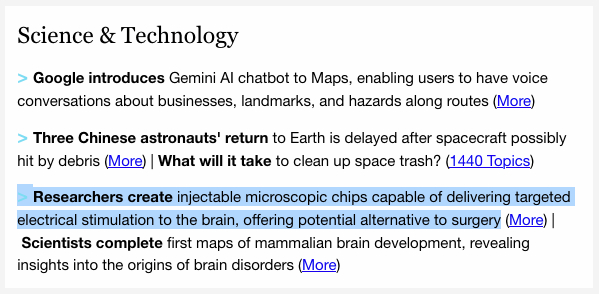Hmmm. Schlumpfstoffe 🤔
#mussmanwissen #geistheilersananda_zitate #Verschwörungstheorien #verschwörungserzählungen #überschwurbellachen #nanobots #dergoldenealuhut
#nanobots
Nanobots that repair Teeth
Nanorobots transform stem cells into bone cells #bioengineering #nanobots https://www.sflorg.com/2025/11/beng11112501.html
About a decade ago, I had an idea for a screenplay involving #NanoBots in people's brains that were supposed to alleviate #Dementia &/or other neurological disorders, but were commandeered by a bad actor, kind of #Manchurian style. And now it's probably coming true IRL.
construction from historic design documents, by bespoke bots
#Nanobots #Futuristic #Construction #Design #Geometric #SolarPanels #Modern #Surreal
#Img2img #AiArt #AiArtists #AiArtCommunity #StableDiffusion
want? have: https://aieris.art/featured/construction-from-historic-design-documents-by-bespoke-bots-eris-and-ai.html
The Miniature Medics: How Nanobots Are Engineering The Future Of Healthcare.
#Nanobots #FutureOfMedicine #PrecisionMedicine #MedicalRobotics #HealthcareInnovation #CancerTreatment #Nanorobots #MedTech #ScienceTwitter #HealthTech #Biotechnology
TU Chemnitz entwickelt autonome Mini-Roboter, die sich selbstständig koordinieren können. Nanoexperte Prof. Schmidt sieht darin einen Weg zu künstlichem Leben
https://oiger.de/2025/08/24/sachsen-falten-den-weg-zum-kuenstlichem-leben/195026
#Robotik #Kollektiv #Nanobots #Smartlets #künstlichesLeben #Arificiallife #Nanotechnologie #Roboter #autonom Systeme #Origami #selbstorganisiert #TUC
Magnetic NanoBots Relieve Nagging Tooth Sensitivity. Nanobots deliver calcium silicate plugs to protect and close microscopic dental channels that all fluid and food to reach sensitive nerves. #nanobots #dental #pain #dentinaltubules #bioceramic
https://www.instagram.com/p/DNd5NZfu7xU/
Wieder lieferbar mit meinem Cover 🤩.
https://timokuemmel.wordpress.com/2025/05/27/versuchsreihe-13-die-epidemie-2/
#uwehermann #sciencefiction #scifi #scifibücher #scifibooks #lesetipp #buchtipp #germanbookstagram #timokümmel #timokuemmel #scifibuch #scifigeek #bookstagramgermany #bookstagramdeutschland #bookstagram #buch #lesen #bücherwurm #büchertipp #postapokalypse #Hamburg #Epidemie #Nanoroboter #Nanobots #Seuche #infiziert #Infizierte #nearfuture
Transmorphers: Mech Beasts
https://frimoulux.com/transmorphers-mech-beasts/
#TomArnold #MatthewGademske #GeenaAlexandra #ToddKarner #JoleneAndersen #AnthonyJensen #CharlotteBjornbak #MarkJustice #TaniaFox #ChadRidgely #ScienceFiction #Robots #Extraterrestres #Suite #TheAsylum #Action #Futur #2324 #Nanobots #NouvelleLosAngeles #LionRobotique #Armes #Bunker #EffetsSpéciaux #Apocalypse #Combat #Technobabble #Transformation #MenaceAlien #Transmorphers #TerreReconstruite #DestructionPlanétaire #Invasion #RésistanceHumaine
the nanobots built a music box but only they can hear it
#Nanobots #MusicBox #Intricate #Metallic #Colorful #Cube #MacrophotographyStyle #Surreal #Mechanism
#Img2img #AiArt #AiArtists #AiArtCommunity #StableDiffusion
want? have: https://aieris.art/featured/the-nanobots-built-a-music-box-but-only-they-can-hear-it-eris-and-ai.html
" #Nanobots Will Be Flowing Through Your Body by 2030" #science
https://interestingengineering.com/innovation/nanobots-will-be-flowing-through-your-body-by-2030
The #NanoBots Are Coming, How Will They Affect Us In The Future? by #CuriousDroid
https://yt.drgnz.club/watch?v=x1StXVDRXyg
Bckp.:
WOLFSZONE von Christian Endres - jetzt zum Aktionspreis als E-Book für nur 4,99 € 🤩.
Mein neues Insta-Reel und eine unbedingte Leseempfehlung
https://www.instagram.com/reel/DA_AehetcSM/
#wolfszone #heyne #cyberthriller #hardboiled #climatefiction #scifibücher #scifithriller #scifikrimi #thrillerbücher #lesetipp #buchempfehlung #thriller #noir #nearfuture #buchvorstellung #kriminoir #bücherwurm #lesezeit #thrillerzeit #ki #nanobots #klimawandel #cyborg #krimi #sciencefiction
"After injecting several hundred billion [300 nm #nanobots] into a rabbit's artery, the scientists used magnets & medical imaging technology to cause the bots to cluster together inside an aneurysm. ... The bots were then heated to their melting point. The process released a naturally occurring blood-clotting protein to prevent or stop the aneurysm bleeding into the brain" http://theregister.com/2024/09/07/nanobots_brain_aneurysms
Un lungo post sul #Giappone che avrebbe vietato il #vaccino anti-#COVID19 perché pieno di #nanobots che controllano le menti non è solo una #fakenews, ma si rivela redatto con l'aiuto dell'#AI
Per dettagli: https://www.bufale.net/il-giappone-scopre-nanobot-nei-vaccini-e-li-abolisce-solo-nelle-fantasie-novax-con-un-aiuto-dellai/
Japan has not declared a state of emergency over alleged "nanobots" found in citizens, debunking viral claims circulating online. 🧐🚫 The truth? No evidence supports these alarming assertions! Let's focus on facts, not fiction. 📊 #FactCheck #Japan #Nanobots #Misinformation #StayInformed
🤣🤣🤣 #nanobots 🤪
#PostSapiens
#Futurist Predicts #Humans Will Soon #Live 1,000 Years, Thanks to #Nanobots and #AI
https://thedebrief.org/futurist-predicts-humans-will-soon-live-1000-years-thanks-to-nanobots-and-ai/




